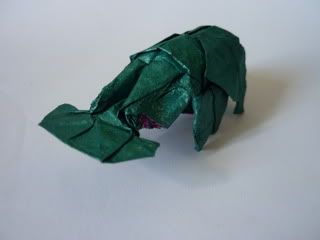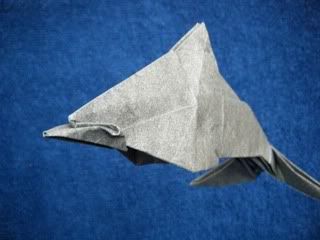Playing around with color changes has always been a lot of fun to me, because I like the idea of seeing the other side of the paper. Today I was just fooling around with
dragon curves when I picked up a small square (did I mention that I have a little notepad with (formerly) about 1000 5cm squares? Very handy for testing small things on the spot.) and started folding, just to see what kind of things that I could come up with. At first, I couldn't think of much. I decided to fold the bottom corner up to the middle of the top edge, and then base the rest on 90° folds. Eventually, I ended up with this (3 folds, despite there being 4 actual creases):
I knew it looked like something, but I couldn't say what. After turning it around a couple of times, I saw it: it was a hunch-backed man with a shopping bag, if you only looked at the colored parts. Of course, you can interpret it any way that you want to. If you fold with the colors inversed and use a background other than white, you could have a balding man with a moustache.
EDIT: Three and a half years later, I keep seeing this design as a balding man with a moustache. As a result, I decided to fold it with the appropriate colours:











 The second picture is actually the opposite side of the model from the first. I decided not to try making a CP, partly because it would be very hard to fold from because the layers need to be arranged a certain way. The model also has some really nice locks. Not only is the red and white section hard to get apart on its own, but when you add the blue part it can be locked in with diagonal folds on the inside.
The second picture is actually the opposite side of the model from the first. I decided not to try making a CP, partly because it would be very hard to fold from because the layers need to be arranged a certain way. The model also has some really nice locks. Not only is the red and white section hard to get apart on its own, but when you add the blue part it can be locked in with diagonal folds on the inside.
 The diagonal lines that make the grid offset starts from the top 1/4 of the square and goes to the bottom 1/8 in the corners. As you can see, it is based on an 8:8 grid. With the head (on the bottom of the CP), you can make all sorts of different things because there are plenty of flaps. I kept it simple and just added a nose, eyes and ears. You can thin the tail and the very top middle part of the model can make another stripe.
The diagonal lines that make the grid offset starts from the top 1/4 of the square and goes to the bottom 1/8 in the corners. As you can see, it is based on an 8:8 grid. With the head (on the bottom of the CP), you can make all sorts of different things because there are plenty of flaps. I kept it simple and just added a nose, eyes and ears. You can thin the tail and the very top middle part of the model can make another stripe.





